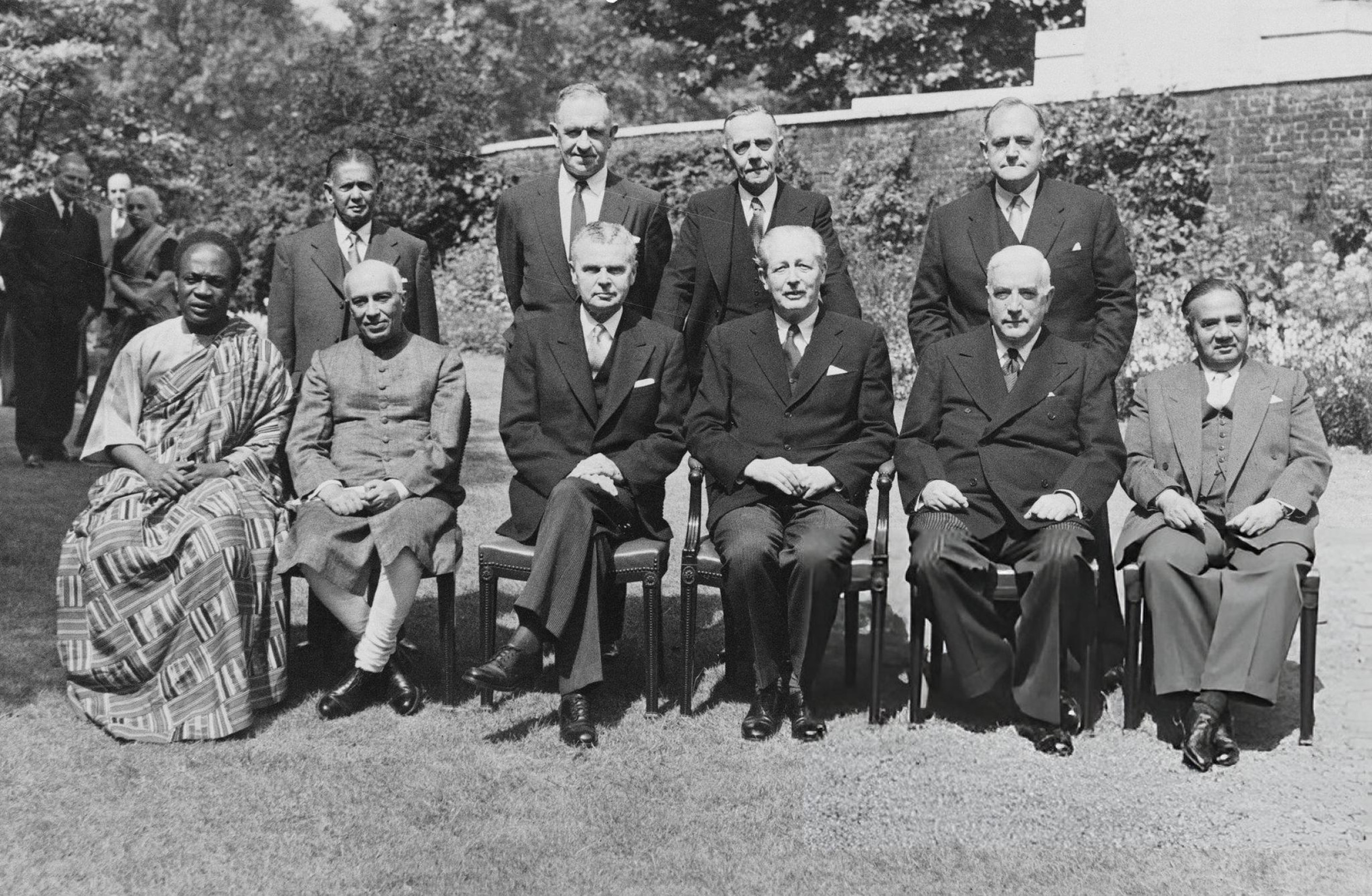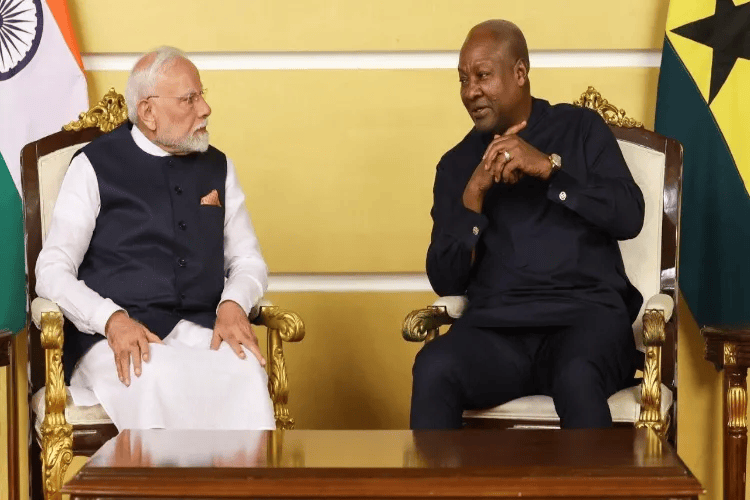Prime Minister Narendra Modi’s July 2025 visit to Ghana marked a milestone in India-Africa relations. It was the first trip by an Indian prime minister to Ghana in over three decades. Modi was greeted with full honors – a ceremonial guard of honor, a 21-gun salute, and enthusiastic chants of “Hare Rama Hare Krishna” from the Indian community in Accra. President John Mahama awarded Modi Ghana’s highest civilian honour, the Officer of the Order of the Star of Ghana. These gestures underscored the visit’s symbolic weight: two long-standing democracies renewing a “comprehensive partnership” that they described as built on “deep-rooted historical ties.” Indeed, Mahama hailed the visit as “a testament to the deep-rooted historical ties” between the nations.
Modi’s Ghana visit was also the opening leg of a five-nation tour (including the Caribbean and Latin America) aimed at strengthening India’s Global South partnerships. Analysts note that Ghana – a relatively stable West African democracy with rich natural resources – was chosen as the first stop to reinforce India’s pivot to Africa and the developing world. By elevating India-Ghana ties to a Comprehensive Partnership (a new status), the leaders signaled a commitment to closer economic, strategic and cultural cooperation.
A Legacy of Friendship: India–Ghana Relations Through the Years
India and Ghana have maintained friendly ties since Ghana’s independence. India established a consulate in Accra in 1953 and formalized relations when Ghana became independent in 1957. The first President of Ghana, Kwame Nkrumah, and India’s first Prime Minister, Jawaharlal Nehru, forged a warm personal friendship. Both countries became founding members of the Non-Aligned Movement, reflecting their shared anti-colonial history and Global South solidarity. State visits have punctuated the relationship: Ghanaian Presidents (from Nkrumah through Kufuor) have visited India, and Prime Minister P. V. Narasimha Rao traveled to Ghana in 1995.

Over the decades, India has invested in Ghana’s development through credit lines and projects. For example, India extended lines of credit (over $228 million) for agro-processing, fish processing, waste management, rural electrification, railways and more. Indian companies like Tata and Ashok Leyland have a visible presence in Ghana’s automobile and IT sectors. By the early 2020s, bilateral trade had steadily grown: it reached about $2.9 billion in 2022–23 and crossed the $3 billion mark by 2025. Ghana’s exports to India include gold, cocoa and timber, while India sends pharmaceuticals, agricultural machinery, electrical equipment, steel and
cement to Ghana. In short, there is a well-established economic relationship upon which both sides can build.
India’s Historic Engagement in Ghana: Modi’s Landmark VisitCultural ties and people-to-people links also run deep. Today roughly 10–15 thousand persons of Indian origin live in Ghana. Many arrived decades ago (some over 70 years), initially as traders or professionals, and have become Ghanaian citizens. Ghana even has an indigenous Hindu population (~13,000 families) that dates back to migration of Sindhi traders after India’s Partition. The Indian community has built temples, schools and cultural centers in Ghana, keeping alive Indian languages, festivals and arts. During Modi’s visit, members of this diaspora rolled out the red carpet: they lined the streets and cheered the prime minister’s arrival with devotional songs. This warm reception highlights the soft power dimension of the relationship.
Signing Four MoUs: Areas of Cooperation Deepen
A highlight of the visit was the signing of four Memoranda of Understanding (MoUs) between India and Ghana to institutionalize collaboration. These MoUs were exchanged during delegation-level talks at Accra’s Jubilee House, with both leaders witnessing the signings. They cover key fields: cultural exchange, traditional medicine, standards and quality, and a joint commission for regular dialogue. Specifically:

- Cultural Exchange Programme (CEP). This MoU establishes an ongoing cultural exchange in art, music, dance, literature and heritage. The aim is to promote tourism and mutual understanding. Ministerial briefings noted that an active CEP could bring Indian film festivals, dance troupes and academic exchanges to Ghana, and Ghanaian cultural troupes to India.
- Traditional Medicine Collaboration. Ghana’s Institute of Traditional and Alternative Medicine (ITAM) and India’s Institute of Teaching and Research in Ayurveda (ITRA) will partner on research, training and education in herbal and traditional medicine. Both countries value their indigenous medical knowledge – Ayurveda in India and African herbal remedies in Ghana – and see this as a chance to innovate in health science.
- Standards and Quality Cooperation. The Bureau of Indian Standards (BIS) and Ghana Standards Authority (GSA) signed an MoU to harmonize product standards and certification. This will help Indian and Ghanaian manufacturers meet each other’s regulations more easily, reducing trade barriers in goods like machinery, electronics and agri-products.
- Joint Commission Institutionalization. A fourth MoU creates a formal Joint Commission Meeting mechanism between India and Ghana. This ensures regular high-level review of bilateral projects and coordinated policy dialogue.
These agreements — on culture, health, industry and government cooperation — demonstrate a holistic partnership vision. They not only open new channels (e.g. academic and technical exchange in traditional medicine) but also institutionalize dialogue (via the joint commission) for ongoing strategic planning.
Expanding Trade and Investment
Modi and Mahama set an ambitious trade target during the visit: double bilateral trade in five years. This is backed by strong Indian investment in Ghana. Indian businesses have invested nearly $2 billion in about 900 projects across Ghana. Sectors include agriculture, manufacturing, and IT – for example, Indian firms supply Ghana’s cars and electronics and help run its mobile networks.

Ghana, for its part, offers attractive opportunities: it is a relatively stable democracy with a growing middle class, making it a gateway to West Africa. The Ghanaian government has its own development goals (like food security and infrastructure expansion) which align well with Indian capabilities in agriculture (seeds, farm tech) and infrastructure. Modi announced that India would support Ghana’s “Feed Ghana” agricultural push and that entrepreneurs would be encouraged to make Ghana a food basket for West Africa. He also pledged Indian help with vaccine production in Ghana, aiming to establish Ghana as a West African vaccine hub with
Indian technology.
Both leaders noted the vast untapped potential in areas like pharmaceuticals, ICT, renewable energy, and mining. At the Joint Trade Committee meeting in May 2024, officials had already identified cooperation areas including pharmaceuticals, healthcare, ICT, agriculture, renewable energy and critical minerals. Ghana is rich in natural resources (notably gold, bauxite and other minerals), and Modi said Indian firms will work on exploration and mining of critical minerals.
This could help Ghana develop downstream industries (refining, processing) rather than just exporting raw ores. At the same time, Ghana can benefit from Indian expertise: India’s National Mineral Development Corporation (NMDC) and private firms have global mining experience that could boost Ghana’s output and value-addition.
On currency and finance, discussions included ways to reduce dependence on the U.S. dollar. The two sides agreed to link their Unified Payments Interface (UPI) systems within six months. This would allow instant, low-cost rupee-cedi transactions – a boon for traders and emitters between India and Ghana. It also reduces currency risk for small businesses. Linking UPI with Ghana’s interbank system follows India’s model of expanding UPI internationally (it is already live in Sri Lanka, UAE, Mauritius, France, etc.). In effect, Indian mobile payment technology could become a bridge to the wider African market, improving financial inclusion.
Much of the economic talk also touched on multilateral trade. Both sides showed interest in the African Continental Free Trade Area (AfCFTA). India is considering how to engage with AfCFTA via partnerships, and discussions included possibilities of working through local currency settlement and AfCFTA standards. The finance linkage and trade initiatives together aim to boost two-way commerce, reduce transaction costs, and integrate Ghana more closely into India’s ‘Act East’ and ‘Global South’ trade networks.
Digital Partnership: UPI and Tech Collaboration
A standout feature of the visit was the focus on digital payments. Modi touted India’s digital public infrastructure (DPI) as a model for Ghana. Specifically, India offered to help Ghana implement UPI-based instant payments nationwide. This would enable Ghanaian users to make fast, secure mobile payments similar to the convenience Indian citizens enjoy today. At a time when many African economies are investing in fintech, India’s UPI (which processes billions of transactions per month) provides a ready-made solution. Ghana’s central bank has indicated plans to adopt UPI, and both governments have agreed to operationalize a UPI-Interbank link, allowing seamless transfers from Ghanaian cedis to Indian rupees.
The impact of this integration could be far-reaching. Small traders could receive payments directly into UPI-linked wallets, reducing cash dependency. Ghana’s diaspora could send remittances home more cheaply through UPI. Ghanaian fintech startups might collaborate with Indian counterparts to create joint digital services. In short, UPI in Ghana would become a pilot for India’s FinTech diplomacy in Africa, leveraging digital connectivity to strengthen economic ties. Other African nations are watching: India aims to export UPI to the continent and has already signed similar agreements with other countries. Thus, the Ghana move fits into a broader strategy of deepening India-Africa digital links.
Beyond payments, the visit signaled cooperation in technology and education. While not formalized in an MoU, both sides discussed expanding internet connectivity, training IT professionals and sharing e-governance know-how. India has offered training slots (through its ITEC programme) to hundreds of Ghanaian officials and students, which has been a backbone of Indian cultural diplomacy. These initiatives help build a friendly cadre of Ghanaian technocrats familiar with Indian systems.
Defence, Security and Strategic Collaboration
India and Ghana also agreed to step up defence and security cooperation, reflecting regional stability interests. Both leaders endorsed the motto “security through solidarity”. In practical terms, this means more joint exercises and training. Indian military instructors will train Ghanaian forces in areas like infantry tactics and peacekeeping, while Ghana can offer insights into maritime security in the Gulf of Guinea (where piracy and smuggling are concerns). Modi noted that India would work with Ghana on maritime security and cyber security, as well as supply parts and equipment if needed.
Counter-terrorism was another key topic. Modi emphasized that “terrorism is the enemy of humanity” and thanked Ghana for cooperating in global anti-terror efforts. Ghana, while not a hotspot of terrorism, contributes troops to UN peacekeeping and has a vested interest in Sahel stability. The two countries agreed to intelligence sharing and joint training exercises to bolster regional security.
Strategically, Ghana’s location makes it a valuable partner. It sits off the West African coast, close to important oil and gas resources (like the Jubilee field). India is a net energy importer, so securing stable energy routes is in its interest. The defense dialogue could thus expand into port development and naval collaboration in the longer term. For Ghana, Indian support adds another dimension beyond its traditional Western and Chinese defence links.
Economic Opportunities for Ghana and India
For Ghana, closer ties with India promise technology transfer, infrastructure development and market access. Indian companies have experience building roads, power plants and railways in Africa. For example, an Indian firm recently upgraded a rail line in Ghana under an Indian LOC (line of credit). During the visit, discussions highlighted new Indian investment in agriculture (seed distribution, agro-tech), pharmaceuticals (medicine plants and vaccine labs), solar energy and skills training. The leaders agreed to double scholarships for Ghanaian students to study in India, and to set up an India-Ghana Skill Centre. These initiatives aim to build Ghana’s human capital for economic growth.
Indian exporters gain access to a gateway into West African markets. By strengthening links with Ghana, Indian businesses can tap not only Ghana’s market (population ~32 million) but also neighboring countries. For instance, once UPI and standards alignment are in place, Indian small traders could more easily do business in Ghana and beyond. The shared language (English) and similar legal systems (Commonwealth heritage) reduce frictions.
Both nations see growth opportunities in new areas. For Ghana, digital infrastructure (IT parks, 5G), healthcare (hospitals, diagnostics) and tourism (religious and medical tourism) are on the table. India could export rural technologies (irrigation, drones for farming) to make Ghana’s “Feed Ghana” campaign more successful. Conversely, Ghana offers India a source of critical minerals (beyond gold, Ghana is exploring lithium and bauxite processing), which are crucial for India’s green transition. Collaborative mining projects could serve India’s goals of securing minerals for electric vehicles and batteries.
The Indian Diaspora and Cultural Diplomacy
India’s diaspora in Ghana – though relatively small (roughly 10–15 thousand) – plays an outsized role in the bilateral relationship. These communities are largely engaged in trade, retail, IT and small industries. They facilitate commerce: Indian grocery stores and restaurants in Accra trade goods with Indian exporters, and Ghanaian artisans find Indian markets and contacts. The powerful chants of “Hare Rama” that greeted Modi’s arrival exemplify how the diaspora reinforces people-to-people bonds.
Cultural diplomacy also featured prominently. The new Cultural Exchange Programme MoU (see above) will expand mutual awareness of art and heritage. Indian cultural organizations like the ICCR and private groups often sponsor Bollywood shows, yoga festivals and Hindi language camps in Ghana; the MoU will formalize and enlarge these exchanges. During the visit, Ghanaian artists performed at the welcome ceremonies, and the theme of shared values (democracy, non-alignment, pluralism) was highlighted. Modi dedicated his Star of Ghana award to “the enduring friendship” between the peoples of India and Ghana. In speeches he frequently
invoked culture – for example quoting Ghanaian sayings and acknowledging shared civilizational connections (such as Ghana’s philosophical tradition of “Sankofa” that resonates with Indian wisdom).
Bollywood and Hinduism have a growing presence in Ghana. Accra’s spice markets sell chutneys and spices, yoga studios are popping up, and visits to the new Hindu temples have become popular excursions. These cultural ties make the partnership more resilient. In practical terms, more Indians are likely to travel, work or study in Ghana, and vice versa: Ghanaian students eye Indian institutes for engineering and medicine. Indeed, the Indian government announced new education scholarships and ITEC training slots for Ghana as part of the visit outcome.
Implications for India–Africa Relations
Modi’s Ghana trip has strategic overtones for the entire continent. It demonstrated India’s commitment to Africa beyond its traditional East African links. Ghana’s location and model democracy make it a beacon for West Africa. By investing political capital here, India signals its intent to engage more deeply with ECOWAS countries (Nigeria, Senegal, etc.) as well. Ghana is also a valuable voice in the African Union: under India’s recent G20 presidency, the African Union won permanent G20 seats – an issue Modi proudly cited during the visit. Ghana’s support in that diplomatic victory is part of a larger pattern of India aligning with Africa on global forums (climate finance, vaccine equity, UN reform).
The visit aligns with India’s broader Africa strategy: Modi had already visited Rwanda and Uganda in 2023, and has repeatedly pledged to boost Africa ties in forums like the India-Africa Forum Summit. By including Ghana (a Commonwealth partner) at the start of his tour, India underscores that its Africa policy covers all regions and language blocs. In bilateral terms, Ghana’s elevation to a Comprehensive Partnership means higher-level summits and more structured engagement; this bodes well for follow-up on projects and for high-level visits both ways in future.
Regional neighbors take note too. Other African countries see that India is serious about digital and trade ties, not just rhetoric. Ghana’s agreement to embrace UPI may inspire nearby countries (like Nigeria, Kenya or Ghana’s Anglophone neighbors) to explore similar linkages. Economically, a stronger India-Ghana corridor could attract Chinese companies to diversify into Indian projects, adding a bit of competitive pressure but also more investment overall. Diplomatically, Ghana may act as a conduit for Indian influence in ECOWAS decision-making.
For India, the visit also served as a message to the Global South. It reminded the world of the India-Africa “civilizational” connection – dating back to ancient trade – and of India’s vision of a multipolar, non-aligned world. Foreign analysts noted that Modi’s speech emphasized dialogue over conflict and South-South cooperation. Indeed, his line “we believe this is not the time for war; problems must be solved through dialogue and diplomacy” – delivered in Ghana – resonated widely. This was likely a subtle critique of global tensions (e.g. in West Asia and Europe) and an attempt to rally newly aligned nations around peaceful development.










